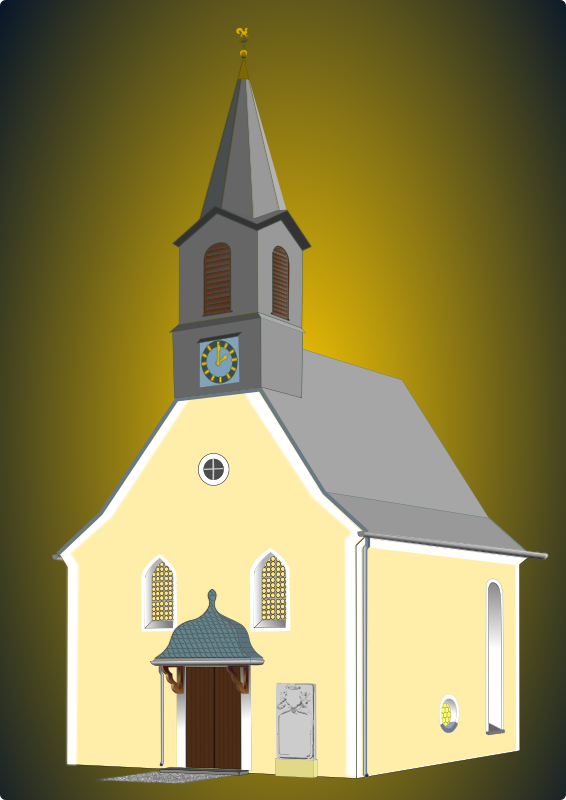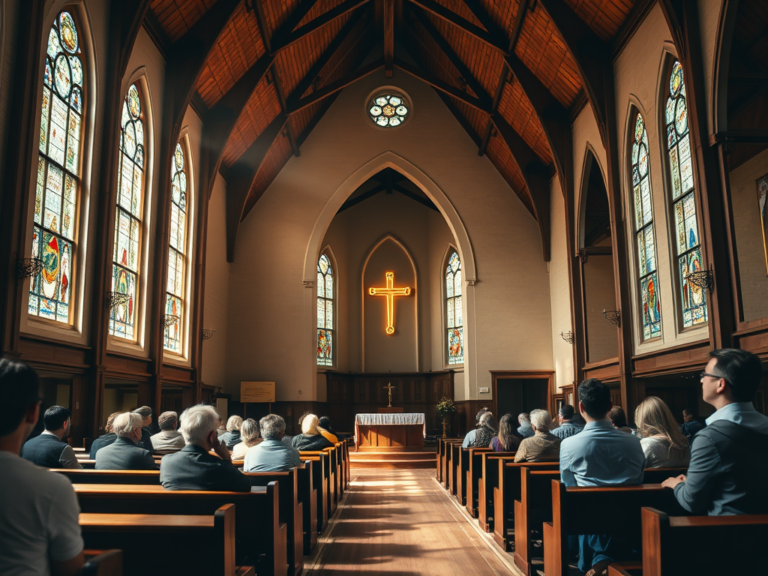My Problem with Church Buildings
Some time ago, in fact, on the trip Jody and I took when she met my parents, I had a half-awake dream/vision. I saw a little church building in a mountain valley. I woke up and told Jody about it and that I thought we’d see it on the trip and we would stop and pray for the people there. As we were driving through Kentucky, we came around a corner in the mountains and there it was.
I’m not presenting this as a miraculous occurrence, because it has coincidence and selective memory written all over it. What it does show is my own attitude. I really loved that scene. The sun was shining through partial cloud cover, and the valley itself could have served as a painting or photograph. We did, in fact, stop and pray. I still remember the scene, though I can’t remember the name of the town.
I love beautiful church architecture. I like to look at good stained glass windows. There is some stained glass that falls somewhat short of “good.” I love to see and listen to a good pipe organ. I recall a hand carved pulpit I saw once with four historical figures in the church. It was beautiful. I enjoyed it.
Still, I have a problem with all this, and the longer I live, and the more I think about serving Jesus, the more concerned I become.
You see, I believe that our churches, by which I mean the people, should be there to create community, and that community should witness to the love of Jesus. I believe that every member should be a minister, that every member is called to priesthood, and that, indeed, the church as the body of Christ is called to a priestly ministry of connection between the divine and the human. (I’m not going to present arguments for this view here. You can read my post Seven Marks: Genuine Relationships for some quotes and comments from multiple writers.)
I don’t, however, think that our church architecture or our worship practice reflects this reality, or perhaps I should call it a hope. I recall once tweeting during a sermon in which the speaker was lecturing with vigor on the importance of participation, of everyone being involved. I asked the question, “Am I the only one who finds it strange to be lectured on participation in a monologue?” Well, am I?
To me, church architecture speaks separation. We have the raised platform, the decorated pulpit (yes, even the ones I really like), the table that’s sort of like the table of the presence. Worship is guided from the front and the single presenter gives a lecture. When invited to preach I personally like to avoid standing behind the pulpit or lectern, though often this is not possible due to the sound system. Hmmm. Don’t get me started on sound systems!
The sanctuaries of our churches reflect a structure that goes back to ancient temples, in which it very much reflected the separation between the actual divinity, often thought to dwell in a special way in the inner sanctum, and the worshipers outside. The priests, then connected the people to the god(s), though never permanently. The channel was always through the priests.
Now don’t think what follows is “New Testament.” But looking back, we see in Exodus 19:6, that God was inviting all the people to hear. Then in Exodus 20:19, the people indicate they’d rather hear from Moses. Now don’t go into the “those stupid, stubborn Israelites” mode. It’s always entertaining when studying these passages to hear people’s claims of how much more faithful they would have been. So, all ye faithful people, tell me this: What happened to the church? It surely must be a shining light at all times, considering what faultless people we are! Well, perhaps, not so much.
But the book of Hebrews tells us that Jesus opened up a new and living way and invites us to follow it, to each approach the throne of grace boldly. So the separation should go. Yet we put that into practice on a regular basis. We treat the pastor as priest. We have an “active” and “inactive” portion.
I think the fellowship hall is a much better representation of what the church should be. Perhaps we could quit building church sanctuaries and just build fellowship halls with some educational/small group rooms attached. Perhaps we could have each Sunday service sitting around tables while we share a meal and all share with one another. Hey, we could even bless this meal and call it communion!
Then we can move the tables and the chairs and share food, clothing, and love with those in need during the week as well. (We did invite them to share our common meal on Sunday, didn’t we?) We could bring them in for social and educational events. We could get everyone involved.
Of course, this is all very frightening. If you get people in touch with the divine on their own, then they may not always follow the directions and ideas of the people in charge. If everyone can participate, someone might say something wrong! What would we do then?
Featured Image Credit: Openclipart.org
I have shocking news for you. Wrong things are said from pulpits around the world every week, and yet here we are. Yes, there are ideas for order, correction, and accountability, ideas that are often not applied to our pastors when they should be. Read 1 Corinthians 12-14 in sequence. What do you think the “edifying” church service in Corinth would have looked like? If Paul introduces ways to correct, is there not a possibility that wrong things got said in this service? That’s where mutual accountability comes in. I’ve seen churches where there were designated people to do correction or to choose who could speak. That’s not what I’m talking about. I’m talking about mutual accountability, where everyone and everything can be questioned and discussed.
A couple of weeks ago I posted this quote from author Herold Weiss, from his book Meditations on According to John:
The sacraments were established toward the end of the first century when Christianity was becoming institutionalized and starting to create official channels through which the Holy Spirit could flow under ecclesiastical control. — Herold Weiss, Meditations on According to John, p. 152.
I think a great deal of what we do is designed to help the Holy Spirit blow where we desire, not where he desires (John 3:8). Or rather, our problem is that people may mistake the leading of the Holy Spirit if they don’t have our help. We want the Spirit flowing under ecclesiastical control, along with the worship service, the presentation of the Word, and all activities of the church.
And right there in our church architecture we embalm and entomb this attitude that suggests that people in general are incapable of knowing God’s will, and need the leaders of the church to keep them straight. Is there value in expert teachers? Of course! But when those expert teachers become expert controllers, then community suffers. They can make points that are quite accurate, while destroying the practical impact of what they teach. They can become, like that speaker I mentioned advocating participation, advocates of something they will not do.
Do we trust in God? That’s always a good question. Generally, I think, we’re afraid that God can’t lead people where God wants them to go. We’d like a mighty wind of the Holy Spirit, but only if that wind blows in a wind tunnel of our choosing, preferably without mussing up our hair.




Henry, lurking behind the curtain here is something that needs to be brought onto stage center–the role of “professional clergy” (of which I am one). We act too often out of job preservation when what is needed is modeling the servant. If a congregation adopts the spirit you recommend here, hierarchal divisions will disappear, and inclusion will prevail. “Professional” clergy will then be unnecessary; servant clergy (equippers) will be in high demand. But that day is far from us. Perhaps the Holy Spirit is preparing the church for renaissance by making it harder and harder for churches to support the pros, forcing them to forego the “hired guns” and look within.
This is not to demean all clergy, for there are many who resist the forces that would make them servants of the institution instead of the people. But in our Fake News and Alternate Truths environment, authenticity is seldom noticed, and rarely rewarded.
I have a high degree of respect for the clergy, but not for the demands placed on them, especially the expectation that they do the work rather than equip the membership to do the work. I would not want anything I say to be seen as against the people involved. It is, however, perhaps similar to my support of troops fighting a war of which I don’t approve, including myself when I was in the Air Force!
I expected you to mention the horrendous cost of maintaining some of those buildings (as that’s a big factor here, where the two churches I attend most frequently both date in significant part from the 11th century), but yes, I agree. OK, those I attend have the altar as the focus point – but it’s far up in the east end, with the privileged few (the choir) occupying the space closest to it. But they have elevated pulpits – as have most churches I’ve ever attended here. The vicar at my local parish church almost never uses that, preferring to speak from ground level – but he’s still at the front, addressing an audience. OK, they also do one service a month in a “cafe” style in the church hall, which is much less formal…
I’d really like to see a system where, either as part of the service or immediately after it, people discussed the content of the sermon. I might even live to see that happen!
I have experienced the response to a sermon when preaching at the Unitarian-Universalist Church of Pensacola. In the past they had that as a regular part of the service. I found that the most stimulating part of the service. I should mention that I find preaching an unnatural act, demanding much effort and restraint on my part!
Very interesting insights, regarding the sanctuary, to ponder next time I attend Mass. However the editor in me also would like to point out paragraph 2, sentence 4; did you mean ‘sun’ instead of ‘son’ or did you mean ‘Son’
Have a blessed day.